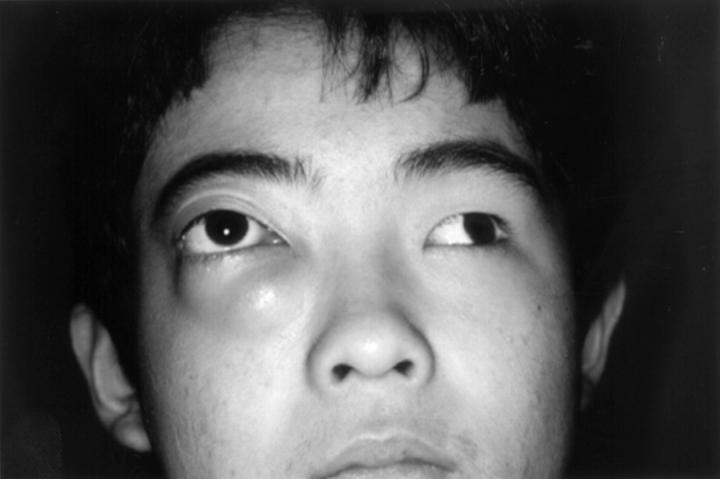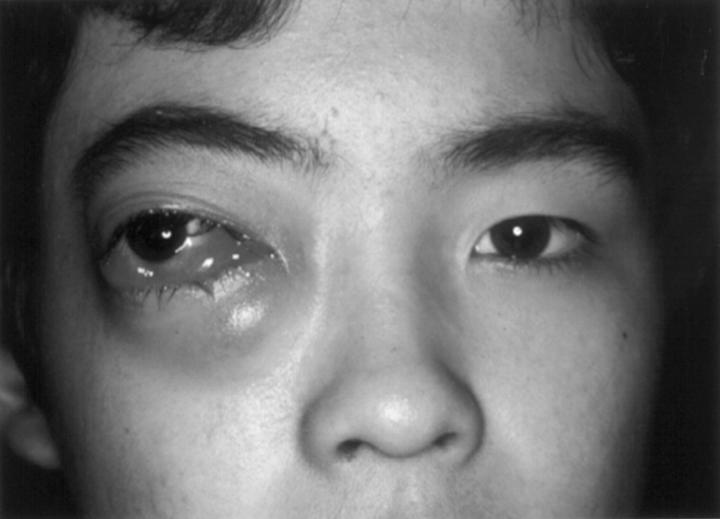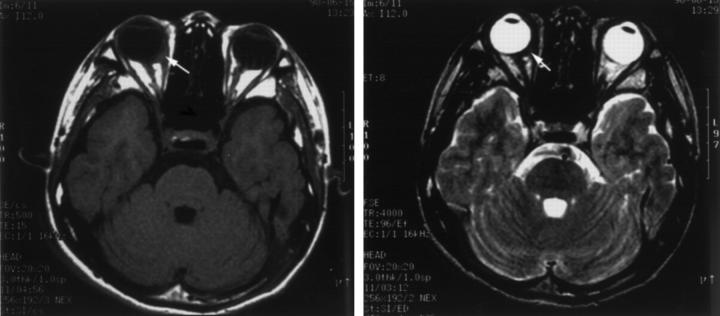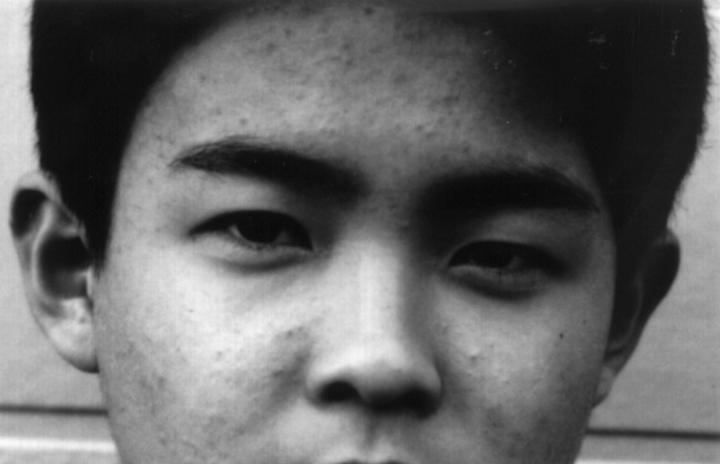Abstract
AIM—To treat orbital lymphangioma with an intralesional injection of OK-432 (group A Streptococcus pyogenes of human origin). METHOD—A 14 year old boy had a right orbital cystic lymphangioma. The visual acuity in the eye was 20/28. In an initial treatment, 0.02 mg of OK-432, was injected into the tumour after aspiration of the fluid contents, but no effect was seen. The second treatment was performed with 0.04 mg of OK-432. RESULT—4 months later, the lesion had totally shrunk to fibrous tissue. The side effects were fever, a local inflammatory reaction lasting 3 days, and increased intraocular pressure, which was managed by draining the fluid contents. Visual acuity improved to 20/15, and the visual field defect and restriction of eye movement seen before treatment disappeared. No recurrence was noted 1 year after treatment. CONCLUSION—An intralesional injection of OK-432 shrunk the lymphangioma without functional disturbance and scar in the facial skin. OK-432 may be useful for orbital lymphangioma, but further studies are still warranted to determine efficacy, complications, and the optimal dose for safe treatment.
Full Text
The Full Text of this article is available as a PDF (143.7 KB).
Figure 1 .
The patient before treatment. Note the distinct proptosis and the dislocation of the right eyeball laterally and upward.
Figure 2 .
(A) T1 and T2 weighted images of a magnetic resonance image before treatment (horizontal section): note the high signals and septal structures inside. (B) T2 weighted images in sagittal section. A cystic tumour continues to the lower eyelid.
Figure 3 .
Swelling of the eyelid, redness, and conjunctival oedema are seen 7 days after the second intralesional injection of OK-432.
Figure 4 .
T1 and T2 weighted images from a magnetic resonance image done 4 months after the second intralesional injection of OK-432 demonstrate that the tumour had shrunk considerably and its aqueous component had disappeared.
Figure 5 .
The patient 12 months after the second injection of OK-432. There was no tumour recurrence.
Selected References
These references are in PubMed. This may not be the complete list of references from this article.
- Bond J. B., Haik B. G., Taveras J. L., Francis B. A., Numaguchi Y., Mihara F., Gupta K. L. Magnetic resonance imaging of orbital lymphangioma with and without gadolinium contrast enhancement. Ophthalmology. 1992 Aug;99(8):1318–1324. doi: 10.1016/s0161-6420(92)31809-3. [DOI] [PubMed] [Google Scholar]
- Char D. H., Sobel D., Kelly W. M., Kjos B. O., Norman D. Magnetic resonance scanning in orbital tumor diagnosis. Ophthalmology. 1985 Oct;92(10):1305–1310. doi: 10.1016/s0161-6420(85)33863-0. [DOI] [PubMed] [Google Scholar]
- Harris G. J., Sakol P. J., Bonavolontà G., De Conciliis C. An analysis of thirty cases of orbital lymphangioma. Pathophysiologic considerations and management recommendations. Ophthalmology. 1990 Dec;97(12):1583–1592. doi: 10.1016/s0161-6420(90)32370-9. [DOI] [PubMed] [Google Scholar]
- Hemmer K. M., Marsh J. L., Milder B. Orbital lymphangioma. Plast Reconstr Surg. 1988 Aug;82(2):340–343. doi: 10.1097/00006534-198808000-00024. [DOI] [PubMed] [Google Scholar]
- Iliff W. J., Green W. R. Orbital lymphangiomas. Ophthalmology. 1979 May;86(5):914–929. doi: 10.1016/s0161-6420(79)35441-0. [DOI] [PubMed] [Google Scholar]
- JONES I. S. Lymphangiomas of the ocular adnexa. An analysis of sixty-two cases. Am J Ophthalmol. 1961 Mar;51:481–509. doi: 10.1016/0002-9394(61)92094-3. [DOI] [PubMed] [Google Scholar]
- Ogita S., Tsuto T., Deguchi E., Tokiwa K., Nagashima M., Iwai N. OK-432 therapy for unresectable lymphangiomas in children. J Pediatr Surg. 1991 Mar;26(3):263–270. doi: 10.1016/0022-3468(91)90500-s. [DOI] [PubMed] [Google Scholar]
- Ogita S., Tsuto T., Nakamura K., Deguchi E., Tokiwa K., Iwai N. OK-432 therapy for lymphangioma in children: why and how does it work? J Pediatr Surg. 1996 Apr;31(4):477–480. doi: 10.1016/s0022-3468(96)90478-9. [DOI] [PubMed] [Google Scholar]
- Ogita S., Tsuto T., Tokiwa K., Takahashi T. Intracystic injection of OK-432: a new sclerosing therapy for cystic hygroma in children. Br J Surg. 1987 Aug;74(8):690–691. doi: 10.1002/bjs.1800740812. [DOI] [PubMed] [Google Scholar]
- Okamoto H., Shoin S., Koshimura S., Shimizu R. Studies on the anticancer and streptolysin S-forming abilities of hemolytic streptococci. Jpn J Microbiol. 1967 Dec;11(4):323–326. doi: 10.1111/j.1348-0421.1967.tb00350.x. [DOI] [PubMed] [Google Scholar]







